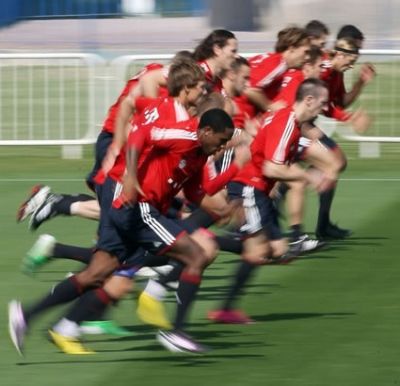
Training the energy systems
(Aerobic system)
The aerobic energy system is the one you use when you engage in moderately intense exercise for over two minutes. It is responsible for what is commonly known as “stamina,” or how long you are able to sustain an activity.
For soccer, this is especially critical, as you frequently run back and forth across the field without any rest periods. To train this energy system efficiently, include two or three longer steady-state cardio sessions in your workout.
You will get the best results from running — either outdoors or on the treadmill. Maintain a moderate pace for 30 to 45 minutes.
(Anaerobic system)
The anaerobic system allows you to perform all the stop-and-go movements involved in soccer. Over the course of a game, you often need to run at an “all out” speed, then quickly recover so you can do it again.
To accomplish this, add one or two interval training sessions to your workout. Run as fast as you can for 30 to 60 seconds, followed by a period of light activity for one to two minutes. Repeat this process six to eight times.
By training this way, you will also increase your body’s ability to handle lactic acid, therefore reducing your chances of fatigue.
(Training for agility)
Agility training can be accomplished through a series of exercises that involve attaching a rope to a weight sled. Perform 8 to 12 reps of each exercise, for a total of two working sets.
(Bilateral drills)
For these exercises, tie a rope to each leg.
Bear Crawl: Get down on your hands and knees and pull the sled along the ground.
Forward Walk: A simple forward walk, focusing on snapping each leg through the movement.
High Knee: Similar to the forward walk, but raise your knee as you walk forward.
Lateral Slide: Walk laterally using a slow and controlled step.
(Unilateral drills)
For these exercises, tie a rope only to one leg at a time.
Forward Walk: Same as the bilateral exercise, but with only one leg.
Lateral Push Slide: Attach the sled to the lead leg, which you will then push over the other in a lateral direction.
X-Over: The same motion as the lateral push slide, but with the rope attached to the trail leg, which you cross over the lead leg.
Lateral Pull Slide: Attach the rope to the trail leg and take a large side step with the lead leg. Then, bring the trail leg to the lead leg without crossing over (use a wide step).
Backward Walk: Focusing on one leg at a time, perform a backward walk, staying low to the ground.
(Training for strength)
The final aspect you need to be concerned with is that of leg and core strength. Do traditional strength-training exercises to develop a strong and powerful lower body.
Complete four sets of six reps for each of the following exercises. Focus on pushing as much weight as you can and move the weight through the range of motion as fast as possible. This will help to develop not only leg strength, but also power.
Barbell Squat: Stand and rest a barbell on the back of your shoulders. Slowly squat down, keeping your knees in line with your toes.
Stiff-Legged Deadlift: Place a barbell on the floor. Stand with your feet shoulder-width apart and grasp either end of the barbell, keeping legs straight (but not locked or hyper-extended). Slowly rise to a standing position and lower once again.
Lunges: Hold a dumbbell in each hand and take a long step forward. Slowly lunge down, and then rise back up as fast as you can.
Hanging Knee Raise: Grasp an overhead bar and lift yourself off the ground. Then, raise your legs up to at least 90 using your abdominal muscles.
